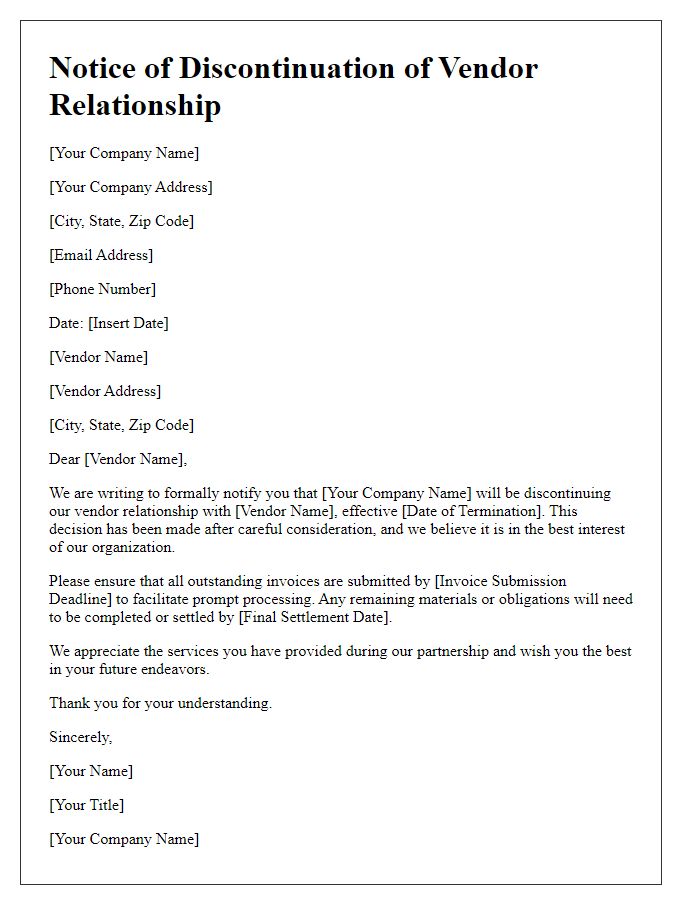Are you considering a vendor contract termination and unsure how to approach it? Navigating the process can feel daunting, but having a clear and professional letter can make all the difference. In this article, we'll guide you through crafting a termination letter that communicates your intentions while maintaining a respectful tone. Stick around as we provide helpful tips and a handy template to make this task easier for you!

Clear Subject Line
Vendor termination contracts often include various critical elements to ensure clarity and compliance. A well-structured subject line, such as "Notice of Contract Termination for [Vendor Name] Effective [Termination Date]," immediately informs recipients of the document's purpose and the involved parties. Important details within the body may highlight reasons for termination, including performance issues, contractual breaches, or strategic shifts in business needs. Specific dates, terms, and obligations should be outlined to avoid misunderstandings. Communication channels and next steps, such as return of assets or settlement of outstanding invoices, also play a vital role in the process, ensuring a smooth transition post-termination. This clarity promotes professionalism in the vendor relationship.
Effective Date of Termination
A vendor termination contract outlines the end of a business relationship. The effective date of termination specifies the precise date when the vendor's services cease. For example, if a vendor contract was established on January 1, 2021, and the termination effective date is set for December 31, 2023, this marks the conclusion of all contractual obligations. Stakeholders must consider various factors such as outstanding payments, return of property, and final reporting obligations. Clarity regarding the effective date prevents misunderstandings and ensures compliance with legal protocols.
Reason for Termination
Vendor termination contracts often arise due to issues like consistent delivery failures or quality concerns. The reason for termination should be clearly stated, such as repeated delays in shipment exceeding 30 days, or unmet product specifications leading to substandard performance in accordance with industry standards. Providing documented evidence of these issues helps support the decision. In many instances, a vendor may fail to comply with contractual obligations laid out in agreements dated January 1, 2023, which can justify termination under Section 5 of the contract. Clear communication of reasons ensures transparency and may facilitate future business relations or resolutions.
Obligations and Responsibilities
In a vendor termination contract, clearly outlining obligations and responsibilities is crucial for preventing disputes. The vendor, such as a supplier or service provider, may be required to cease all services by a specified date, such as 30 days after notice delivery, ensuring minimal disruption. The vendor must also return any proprietary materials or confidential information, including documents and digital files, that belong to the contracting party, usually within a stipulated timeframe. Final payments should be settled, encompassing outstanding invoices and any agreed-upon penalties for breach of terms, ensuring clarity on monetary responsibilities. Document retention protocols, outlining how long records should be kept post-termination, may also be included. Furthermore, compliance with local laws, such as the GDPR for data protection in Europe, emphasizes the legal responsibilities tied to vendor termination agreements.
Contact Information for Further Communication
Effective vendor termination requires precise documentation and communication. Key elements include the vendor's name, address, and contact information. For instance, a vendor might be located at 1234 Business Lane, Springfield, IL. Essential contacts may include the Vendor Relationship Manager, such as John Doe at johndoe@email.com or (555) 123-4567. Clear communication channels ensure smooth handover processes, maintaining professional relationships even during termination. Additional notes might contain reasons for termination, final settlements details, and the deadline for the return of any company property, ensuring all parties are informed and engaged during this transition.













Comments